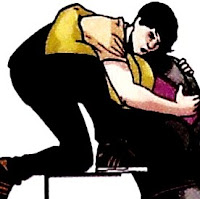 |
| my drawing / mi dibujo |
Lima was known as the city of the kings because it was ruled by a viceroy in the colonial age; and it was the most important and richest colony of Spain back then. There were viceroys and some nobility from Spain; and nowadays a lot of rich people can still count among their friends a certain amount of European nobles, funny, isn't it? Some 500 years ago, the Incan Empire was bigger than Peru, Colombia, Brazil and Chile put together, but after the conquest Spain divided the territory in smaller parts so that it would be easier to rule. There was an indigenous population of roughly 12 million, and after fifty years of Spain dominance, the population decreased to 300 thousand. Some people don't believe in the numbers, or don't want to acknowledge the brutal colonization.
Civilization or barbarism has been a recurrent theme here or in other countries, Argentina, for example, took a more active approach and they dramatically reduced the amount of indigenous population, hence you find a lot more white people in Buenos Aires today than you will find here in Lima. In the 19th century Peru became an independent country after a lot of battles with Spain, and presidents (and much more dictators that I would care to admit) became the rule.
Yeah, I know none of that has anything to do with comics, but wouldn't it be great to write a story about it. I can already imagine how I would like to see it illustrated.
______________________________________________________________
______________________________________________________________
Hace un par de horas se inauguraron varias muestras en el Centro Colich, en Barranco: la colección Otoño-Invierno 2013 de Jabbour Balmelli, Abracadabra (Eco Diseño Chic) y Conjunciones: simbólicas de Brian Silva Maldonado. Los cuadros de este artista son, ciertamente, estrambóticos pero muy cautivadores. Capa tras capa de pintura retroalimentan un flujo constante de líneas y figuras, en algunas casos la imagen alude a formas insectoides, en otros, a formas parasitarias. Silva Maldonado despliega su propuesta con rigor y coherencia, creando cuadros de gran impacto visual. Sin duda, su creatividad se hace evidente en “Gran madre” y “Cuerno rojo”. De lo mejor que he visto en Colich en los últimos meses, vale la pena que se den una vuelta por el jirón Colina 110 en Barranco (la muestra dura hasta el 20 de abril).
En el transcurso de la noche me encontré con Julio Garay y José Medina, que le contó a todo el mundo que estaba trabajando en COSAS, aunque, siempre tan exagerado, les dijo que tenía un cargo mucho más importante del que tengo. También me encontré con Lothar Busse, el director del Centro Colich, quien tuvo la amabilidad de ofrecerme un par de chilcanos pese a que ya no los estaban repartiendo al público debido a la hora (es cierto, llegué tardísimo). Y, desde luego, me quedé conversando un buen rato con Paola Tejada y Marcos Palacios.































































































